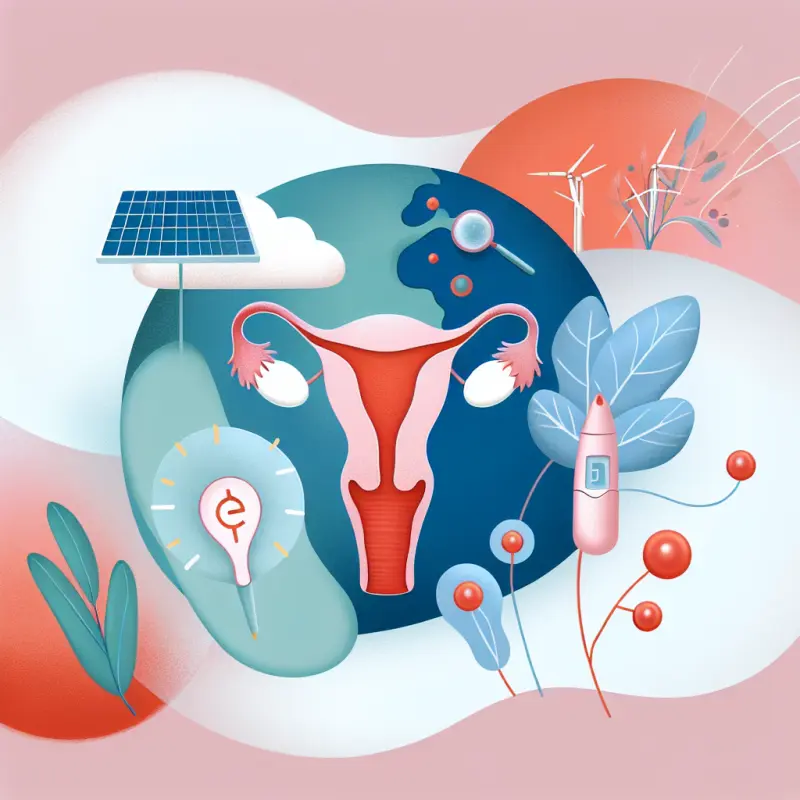Climate Change and Menstrual Health: Emerging Research

Climate Change and Menstrual Health: Emerging Research
Introduction
Climate change is one of the most pressing issues of our time, affecting countless aspects of life on Earth. While much attention has been given to its impacts on biodiversity, agriculture, and human health, a crucial area that has been relatively under-researched is the intersection between climate change and menstrual health. Menstrual health is a critical component of overall health for half the global population, influencing physical, mental, and social well-being. This article explores the emerging research on how climate change impacts menstrual health and discusses the implications for policy and practice.
The Intersection of Climate Change and Health
Climate Change: A Brief Overview
Climate change refers to long-term shifts in temperatures and weather patterns, primarily driven by human activities like burning fossil fuels. These changes have far-reaching effects on ecosystems, economies, and human societies. The primary manifestations include:
- Rising Global Temperatures: Increased temperatures affect ecosystems and human health.
- Extreme Weather Events: More frequent and severe hurricanes, floods, and droughts.
- Sea Level Rise: Threatening coastal communities and ecosystems.
- Changes in Precipitation Patterns: Affecting water availability and agriculture.
Impact on Human Health
The health impacts of climate change are diverse and complex, including:
- Heat-Related Illnesses: Increased temperatures can lead to heat stress and exacerbate chronic conditions.
- Vector-Borne Diseases: Changes in climate affect the distribution of disease-carrying organisms.
- Food and Water Security: Altered ecosystems affect food production and water supply.
- Mental Health: Increased stress and anxiety due to environmental changes and natural disasters.
Climate Change and Menstrual Health: Emerging Research
Understanding Menstrual Health
Menstrual health encompasses the biological, psychological, and social aspects of menstruation. It involves access to menstrual products, education, sanitation facilities, and the absence of stigma. Key components include:
- Access to Menstrual Products: Essential for hygiene and comfort.
- Education: Understanding menstruation and reproductive health.
- Sanitation Facilities: Availability of clean and private spaces for menstrual management.
- Social and Cultural Attitudes: Reducing stigma and promoting menstrual equity.
The Impact of Climate Change on Menstrual Health
Accessibility and Affordability of Menstrual Products
- Supply Chain Disruptions: Extreme weather events can disrupt the production and distribution of menstrual products, making them less accessible and affordable.
- Economic Impacts: Climate-induced economic instability can reduce household income, making it difficult for individuals to afford menstrual products.
Water and Sanitation Challenges
- Water Shortages: Changes in precipitation patterns can lead to water scarcity, affecting personal hygiene and the ability to wash reusable menstrual products.
- Inadequate Sanitation Facilities: Flooding and infrastructure damage can compromise sanitation facilities, making it difficult for individuals to manage menstruation with dignity.
Health and Biological Implications
- Heat Stress and Menstrual Cycle: Emerging research suggests that extreme heat can affect the menstrual cycle, potentially leading to irregularities.
- Nutritional Deficiencies: Climate change impacts food security, leading to potential nutritional deficiencies that can affect menstrual health.
Social and Psychological Impacts
- Increased Stigma and Discrimination: In times of crisis, societal structures may exacerbate stigma around menstruation, limiting access to necessary resources and support.
- Mental Health Concerns: Stress and anxiety related to climate change can exacerbate the psychological challenges associated with menstruation.
Addressing the Challenges: Policy and Practice
Policy Recommendations
Integrating Menstrual Health into Climate Policy
- Inclusive Climate Policies: Ensure that menstrual health is considered in climate adaptation and mitigation strategies.
- Funding and Support: Allocate resources for research and programs that address the intersection of climate change and menstrual health.
Improving Access and Infrastructure
- Investment in Infrastructure: Develop resilient water and sanitation infrastructure to withstand climate impacts.
- Subsidizing Menstrual Products: Implement policies to make menstrual products affordable and accessible, especially in vulnerable communities.
Education and Awareness
- Comprehensive Education Programs: Integrate menstrual health education into broader health and climate education initiatives.
- Community Engagement: Foster community-led initiatives to raise awareness and reduce stigma around menstruation.
Practical Approaches
Sustainable Menstrual Products
- Promoting Reusable Products: Encourage the use of sustainable menstrual products that are less reliant on complex supply chains.
- Local Production: Support local production of menstrual products to reduce dependency on global supply chains.
Enhancing Resilience
- Emergency Preparedness: Ensure menstrual health is included in emergency response plans.
- Community-Based Solutions: Develop grassroots strategies to support menstrual health in the face of climate challenges.
Conclusion
The intersection of climate change and menstrual health is a critical area of emerging research that demands attention from policymakers, researchers, and practitioners. As climate change continues to impact global health, addressing its effects on menstrual health is essential for promoting equity and well-being. By integrating menstrual health into climate policies, improving access to resources, and fostering community engagement, we can build resilience and ensure that menstrual health is prioritized in the face of a changing climate. Embracing this holistic approach will not only improve menstrual health outcomes but also contribute to broader efforts to mitigate and adapt to climate change.